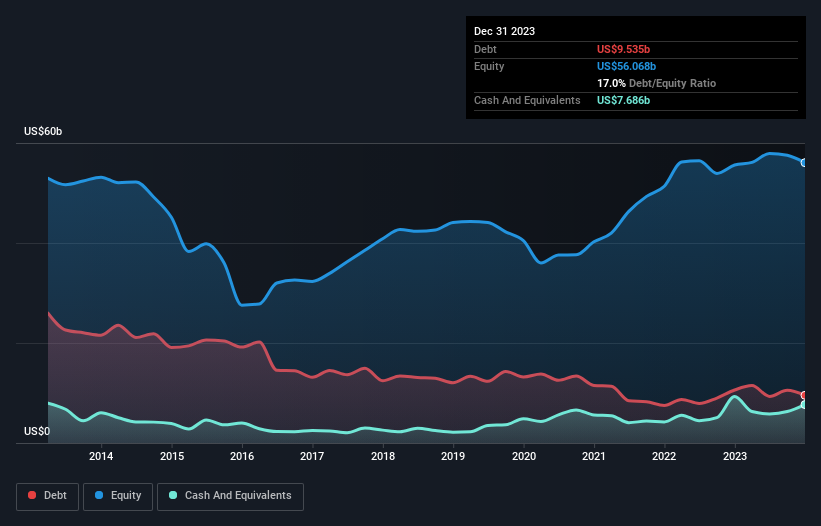- Netherlands
- /
- Metals and Mining
- /
- ENXTAM:MT
These 4 Measures Indicate That ArcelorMittal (AMS:MT) Is Using Debt Extensively

Legendary fund manager Li Lu (who Charlie Munger backed) once said, 'The biggest investment risk is not the volatility of prices, but whether you will suffer a permanent loss of capital.' It's only natural to consider a company's balance sheet when you examine how risky it is, since debt is often involved when a business collapses. We note that ArcelorMittal S.A. (AMS:MT) does have debt on its balance sheet. But the more important question is: how much risk is that debt creating?
Why Does Debt Bring Risk?
Debt and other liabilities become risky for a business when it cannot easily fulfill those obligations, either with free cash flow or by raising capital at an attractive price. If things get really bad, the lenders can take control of the business. While that is not too common, we often do see indebted companies permanently diluting shareholders because lenders force them to raise capital at a distressed price. Of course, plenty of companies use debt to fund growth, without any negative consequences. When we examine debt levels, we first consider both cash and debt levels, together.
See our latest analysis for ArcelorMittal
What Is ArcelorMittal's Net Debt?
You can click the graphic below for the historical numbers, but it shows that ArcelorMittal had US$9.54b of debt in December 2023, down from US$10.6b, one year before. However, it also had US$7.69b in cash, and so its net debt is US$1.85b.

A Look At ArcelorMittal's Liabilities
According to the last reported balance sheet, ArcelorMittal had liabilities of US$21.8b due within 12 months, and liabilities of US$16.1b due beyond 12 months. On the other hand, it had cash of US$7.69b and US$5.20b worth of receivables due within a year. So its liabilities outweigh the sum of its cash and (near-term) receivables by US$25.0b.
Given this deficit is actually higher than the company's massive market capitalization of US$22.1b, we think shareholders really should watch ArcelorMittal's debt levels, like a parent watching their child ride a bike for the first time. Hypothetically, extremely heavy dilution would be required if the company were forced to pay down its liabilities by raising capital at the current share price.
We use two main ratios to inform us about debt levels relative to earnings. The first is net debt divided by earnings before interest, tax, depreciation, and amortization (EBITDA), while the second is how many times its earnings before interest and tax (EBIT) covers its interest expense (or its interest cover, for short). Thus we consider debt relative to earnings both with and without depreciation and amortization expenses.
ArcelorMittal's net debt is only 0.33 times its EBITDA. And its EBIT easily covers its interest expense, being 21.6 times the size. So we're pretty relaxed about its super-conservative use of debt. It is just as well that ArcelorMittal's load is not too heavy, because its EBIT was down 73% over the last year. When a company sees its earnings tank, it can sometimes find its relationships with its lenders turn sour. The balance sheet is clearly the area to focus on when you are analysing debt. But it is future earnings, more than anything, that will determine ArcelorMittal's ability to maintain a healthy balance sheet going forward. So if you're focused on the future you can check out this free report showing analyst profit forecasts.
Finally, while the tax-man may adore accounting profits, lenders only accept cold hard cash. So we always check how much of that EBIT is translated into free cash flow. During the last three years, ArcelorMittal produced sturdy free cash flow equating to 53% of its EBIT, about what we'd expect. This free cash flow puts the company in a good position to pay down debt, when appropriate.
Our View
We'd go so far as to say ArcelorMittal's EBIT growth rate was disappointing. But at least it's pretty decent at covering its interest expense with its EBIT; that's encouraging. Looking at the balance sheet and taking into account all these factors, we do believe that debt is making ArcelorMittal stock a bit risky. That's not necessarily a bad thing, but we'd generally feel more comfortable with less leverage. When analysing debt levels, the balance sheet is the obvious place to start. But ultimately, every company can contain risks that exist outside of the balance sheet. For example - ArcelorMittal has 2 warning signs we think you should be aware of.
At the end of the day, it's often better to focus on companies that are free from net debt. You can access our special list of such companies (all with a track record of profit growth). It's free.
New: Manage All Your Stock Portfolios in One Place
We've created the ultimate portfolio companion for stock investors, and it's free.
• Connect an unlimited number of Portfolios and see your total in one currency
• Be alerted to new Warning Signs or Risks via email or mobile
• Track the Fair Value of your stocks
Have feedback on this article? Concerned about the content? Get in touch with us directly. Alternatively, email editorial-team (at) simplywallst.com.
This article by Simply Wall St is general in nature. We provide commentary based on historical data and analyst forecasts only using an unbiased methodology and our articles are not intended to be financial advice. It does not constitute a recommendation to buy or sell any stock, and does not take account of your objectives, or your financial situation. We aim to bring you long-term focused analysis driven by fundamental data. Note that our analysis may not factor in the latest price-sensitive company announcements or qualitative material. Simply Wall St has no position in any stocks mentioned.
About ENXTAM:MT
ArcelorMittal
Operates as integrated steel and mining companies in the Americas, Europe, Asia, and Africa.
Flawless balance sheet with solid track record.
Similar Companies
Market Insights
Community Narratives





